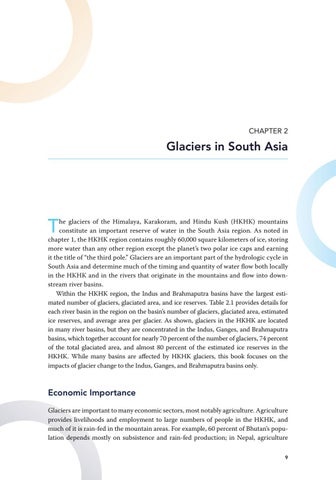CHAPTER 2
Glaciers in South Asia
T
he glaciers of the Himalaya, Karakoram, and Hindu Kush (HKHK) mountains constitute an important reserve of water in the South Asia region. As noted in chapter 1, the HKHK region contains roughly 60,000 square kilometers of ice, storing more water than any other region except the planet’s two polar ice caps and earning it the title of “the third pole.” Glaciers are an important part of the hydrologic cycle in South Asia and determine much of the timing and quantity of water flow both locally in the HKHK and in the rivers that originate in the mountains and flow into downstream river basins. Within the HKHK region, the Indus and Brahmaputra basins have the largest estimated number of glaciers, glaciated area, and ice reserves. Table 2.1 provides details for each river basin in the region on the basin’s number of glaciers, glaciated area, estimated ice reserves, and average area per glacier. As shown, glaciers in the HKHK are located in many river basins, but they are concentrated in the Indus, Ganges, and Brahmaputra basins, which together account for nearly 70 percent of the number of glaciers, 74 percent of the total glaciated area, and almost 80 percent of the estimated ice reserves in the HKHK. While many basins are affected by HKHK glaciers, this book focuses on the impacts of glacier change to the Indus, Ganges, and Brahmaputra basins only.
Economic Importance Glaciers are important to many economic sectors, most notably agriculture. Agriculture provides livelihoods and employment to large numbers of people in the HKHK, and much of it is rain-fed in the mountain areas. For example, 60 percent of Bhutan’s population depends mostly on subsistence and rain-fed production; in Nepal, agriculture 9




